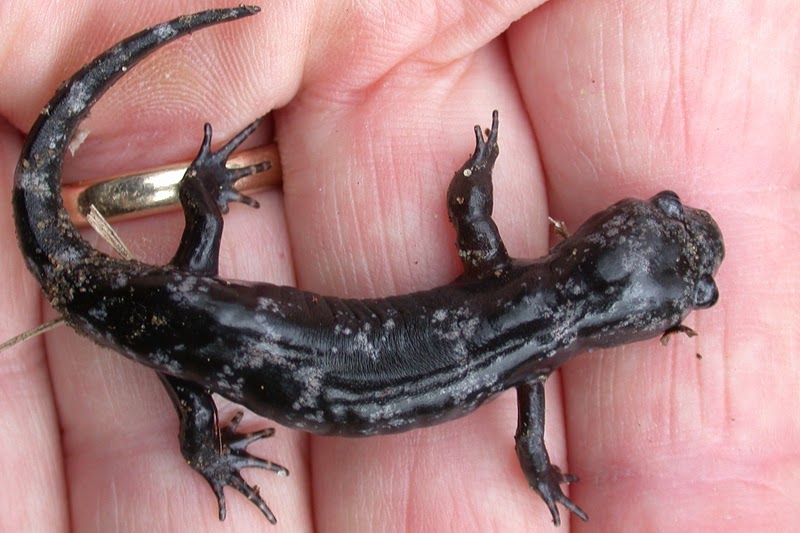So, while you are waiting for the mad rush of spring migratory birds to wash over the landscape, here's a few sings of early spring to be looking out for...
It won't be long before Spring Peepers are becoming, well, annoying! The incredible volume that these inch-long little frogs generate is astounding and will peak in our area during April. But the chorus has started on the one or two days when the temperature has crept up. And one thing is for sure with these amazing little frogs, you will hear tens of thousands - but I bet you see almost none! [Photo by Mike Crewe]
Although they are cold-blooded it amazes me how early in the season that salamanders (like this Marbled Salamander, photographed on March 11th this year) get going. Wet days or evenings in late February or early March are peak times to find these animals out and about, but you still have a few weeks to keep an eye out for them. Marbled and Tiger Salamanders are in a group known as mole salamanders and are so called because they spend much of their life below ground, burrowing through soft earth for invertebrate food [photo by Mike Crewe].
And while you are checking out your local ponds for amphibian activity, keep an eye out for the improbable fairy-shrimps! These creatures appear as if from nowhere when conditions are right, then disappear equally as mysteriously. We'll tell you more about these another time... [photo by Mike Crewe]
Spring flowers don't really 'happen' out on New Jersey's coastal plain until well into April or even early May, but there is still a mass of color to be appreciated from a surprising source - lawn weeds! Lawns are a totally unnatural habitat and, for most wildlife, about as useful as a concrete parking lot. But their saving grace can come in spring (so long as the manicurists are kept at bay for a while!) when bare patches are covered temporarily by a range of European 'weeds'. Though introduced, many of these species show no inclination to spread into natural areas so they don't really qualify as invasives - and many provide vital nectar for early insects. In this photo, Common Dandelion, Red Dead-nettle, Common Bugle and Common Field Speedwell all add color to a roadside in east Cape May. Get out and see how many you can find [photo by Mike Crewe].
Early spring can show itself in surprising ways. For me, one of the first signs is the return of the Fish Crows in March. Recently, up to 300 have been at a traditional pre-season gathering place on Shunpike Road in Cape May. Here, they pair up, performing ritualistic courtship flights and show a lot of interesting behavior that is well worth studying at this time of year. Soon they will disperse to breeding sites (then we have to start battling with them to save the Piping Plovers - another story...) and the spectacle will be over for another year [photo by Mike Crewe].
It's easy enough to miss the switch to spring in the local Red-winged Blackbirds, since the species is here all year. But a walk in any marshy area around Cape May right now will reveal spring fever, as male Red-wings hang on to cattail stems in the breeze and show off their snazzy red epaulets. A sign of spring indeed [photo by Mike Crewe].
Though it is early, you will surely be pleased to hear that warblers are already arriving! First to come is invariably the first pulse of Pine Warblers. This species arrives so early that insects can be tough to find up in the tree canopy, so look for your first Pine Warblers of spring on the ground, where they will be looking for seeds or fallen berries. Around Cape May, a good number also show up at feeders, typically favoring either the suet block, or rummaging around on the ground underneath - this bird was at the Northwood Center on March 14th last year, but we still await their arrival at the feeders this year [photo by Mike Crewe].
It might still be chilly, but spring is most definitely here! Put on gloves and a hat and come and enjoy the magic with us. Check out our Events Calendar and pick something that works for you. See you at Cape May!







No comments:
Post a Comment